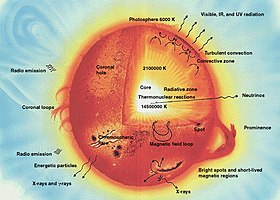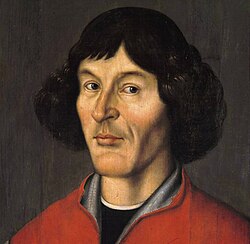Portal:Stars
IntroductionA A star's life .distance, and motion through space—by carrying out observations of a star's apparent brightness, spectrum, and changes in its position in the sky over time.
Stars can form orbital systems with other astronomical objects, as in planetary systems and star systems with two or more stars. When two such stars orbit closely, their gravitational interaction can significantly impact their evolution. Stars can form part of a much larger gravitationally bound structure, such as a star cluster or a galaxy. (Full article...) Selected star - Photo credit: User:Mysid
VY Canis Majoris (VY CMa) is a red semiregular variable and has an estimated period of 2,000 days. It has an average density of 5 to 10 mg/m3. If placed at the center of the Solar System, VY Canis Majoris's surface would extend beyond the orbit of Jupiter, although there is still considerable variation in estimates of the radius, with some making it larger than the orbit of Saturn .
The first known record of VY Canis Majoris is in the star catalogue of Jérôme Lalande, on March 7, 1801. The catalogue listed VY CMa as a 7th magnitude star. Further studies on its apparent magnitude during the 19th century showed that the star has been fading since 1850. Since 1847, VY CMa has been known to be a red star. During the 19th century, observers measured at least six discrete components to VY CMa, suggesting the possibility that it is a high-resolution imaging in 1998 showed that VY CMa does not have a companion star.
Selected article - Photo credit: NASA
thermal conduction is important in white dwarfs. The internal structure of a main sequence star depends upon the mass of the star.
In solar mass stars (0.3–1.5 proton-proton chains, which do not establish a steep temperature gradient. Thus, radiation dominates in the inner portion of solar mass stars. The outer portion of solar mass stars is cool enough that hydrogen is neutral and thus opaque to ultraviolet photons, so convection dominates. Therefore, solar mass stars have radiative cores with convective envelopes in the outer portion of the star. In massive stars (greater than about 1.5 solar masses), the core temperature is above about 1.8×107 K, so hydrogen-to-helium fusion occurs primarily via the CNO cycle. In the CNO cycle, the energy generation rate scales as the temperature to the 17th power, whereas the rate scales as the temperature to the 4th power in the proton-proton chains. Due to the strong temperature sensitivity of the CNO cycle, the temperature gradient in the inner portion of the star is steep enough to make the core convective .
The simplest commonly used model of stellar structure is the spherically symmetric quasi-static model, which assumes that a differential equations: two represent how matter and pressure vary with radius; two represent how temperature and luminosity vary with radius.
Selected image - Photo credit: ESA/Hubble & NASA
Messier 5 or M5 (also designated NGC 5904) is a globular cluster in the constellation Serpens. It was discovered by Gottfried Kirch in 1702. Spanning 165 light-years in diameter, M5 is one of the larger globular clusters known. M5 is, under extremely good conditions, just visible to the naked eye as a faint star. Did you know?
SubcategoriesTo display all subcategories click on the ►
Selected biography - Photo credit: Portrait from Toruń
Copernicus' epochal book, Among the great Catholic cleric, jurist, governor, military leader, diplomat and economist. Among his many responsibilities, astronomy figured as little more than an avocation – yet it was in that field that he made his mark upon the world.
Topics |



